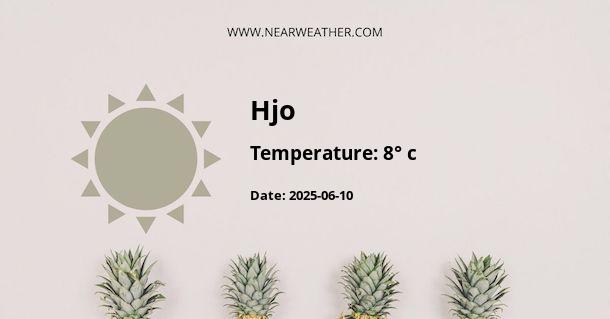Hjo, SE: Climate and Weather Year Round
Hjo is a picturesque town located in the Västra Götaland County of Sweden. Known for its charming waterfront, historical buildings, and scenic landscapes, Hjo attracts visitors from around the world. Understanding the climate and weather patterns of Hjo is essential for visitors and residents alike. In this article, we will explore the climate of Hjo throughout the year, providing detailed information about temperatures, rainfall, and other meteorological factors.
Climate Classification
Hjo has a humid continental climate, characterized by distinct seasons and significant temperature variations throughout the year. The region experiences relatively mild summers and cold winters. The climate in Hjo is influenced by its proximity to Lake Vättern, which moderates the temperatures and affects precipitation patterns.
Spring (March to May)
Spring in Hjo is a beautiful season, as nature awakens from the winter slumber. In March, the average temperature is around 2°C (36°F), gradually increasing to 10°C (50°F) by May. However, it is important to note that spring temperatures can be quite variable, with occasional cold spells and frosty nights.
During spring, Hjo experiences moderate rainfall, with an average of 40-50mm per month. Rainfall is fairly evenly distributed throughout the season, providing the necessary moisture for the plants to flourish.
Summer (June to August)
Summer in Hjo is a delightful time, with pleasant temperatures and long daylight hours. The average temperature in June is around 17°C (63°F) and gradually rises to 22°C (72°F) in August. However, temperatures can occasionally reach as high as 30°C (86°F) during heatwaves.
Hjo experiences relatively low rainfall during the summer months, with an average of 30-40mm per month. The region enjoys around 8-9 hours of sunshine per day, allowing visitors to indulge in outdoor activities and explore the natural beauty of the surroundings.
Fall (September to November)
Fall in Hjo is characterized by stunning autumn colors and cooler temperatures. In September, the average temperature is around 14°C (57°F), gradually dropping to 6°C (43°F) by November. Nights become progressively colder, with occasional frost.
During the fall season, Hjo experiences moderate rainfall, with an average of 40-50mm per month. The changing colors of the leaves create a picturesque backdrop for outdoor enthusiasts and photographers.
Winter (December to February)
Winter in Hjo is a true winter wonderland, with snow-covered landscapes and crisp temperatures. December is the coldest month, with an average temperature of -1°C (30°F). January and February are similarly cold, with average temperatures around -3°C (27°F).
During winter, Hjo experiences moderate to heavy snowfall, creating a magical atmosphere. The region receives an average of 50-60mm of precipitation per month, mostly in the form of snow. The frozen Lake Vättern further enhances the beauty of the surroundings.
Extreme Weather Events
While Hjo generally experiences mild weather conditions, it is important to be aware of potential extreme weather events. Thunderstorms can occur during the summer months, occasionally accompanied by heavy rainfall and strong winds. In rare cases, Hjo may also experience blizzards during winter, which can lead to temporary disruptions in transportation.
Conclusion
Hjo, SE, offers a diverse climate throughout the year, with distinct seasons and varying weather patterns. Visitors can enjoy mild summers, stunning autumn colors, and the beauty of a winter wonderland. It is essential to pack accordingly and stay informed about any potential extreme weather events. Whether you visit Hjo in spring, summer, fall, or winter, the town's charm and natural beauty will captivate you.
A - Hjo's Latitude is 58.301331 & Longitude is 14.287840.
A - Weather in Hjo is -1° today.
A - Climate Conditions in Hjo shows scattered clouds today.
A - Humidity in Hjo is 92% today.
A - Wind speed in Hjo is 14.9 km/h, flowing at 87° wind direction. today.
